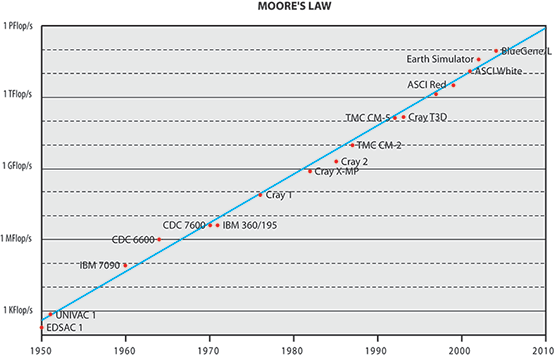Welcome to the inaugural issue of the Cyberinfrastructure Technology Watch Quarterly. We hope that this publication provides a window to the future of the hardware, software and human resources required to build a useful, usable and enabling cyberinfrastructure for science and engineering. Our goal is to provide a venue for describing emerging cyberinfrastructure technologies and discussing current trends and future opportunities, critical information relevant to the building and using of cyberinfrastructure, and a resource for the entire community.
In 2003, the NSF Blue Ribbon Panel on Cyberinfrastructure provided a compelling vision of the future:
“... a new age has dawned in scientific and engineering research, pushed by continuing progress in computing, information, and communication technology, and pulled by the expanding complexity, scope, and scale of today's challenges. The capacity of this technology has crossed thresholds that now make possible a comprehensive ‘cyberinfrastructure’ on which to build new types of scientific and engineering knowledge environments and organizations and to pursue research in new ways and with increased efficacy.”
The Blue Ribbon Panel’s vision of cyberinfrastructure involves the coordination and integration of software, hardware and human resources to enable today's and future science and engineering applications. Coordinating compute, data, visualization, networking, field instruments, and other technologies presents enormous challenges to cyberinfrastructure builders and developers and pushes many of the component technologies to the limits.
Pioneers in the building and using of cyberinfrastructure have included a collection of advanced multi-disciplinary application projects including NSF's Network for Earthquake Engineering Systems (NEES) project (focusing on the development of enabling infrastructure for critical earthquake engineering experiments) and NIH's Biomedical Informatics Research Network (BIRN) project (focusing on distributed collaborations in brain imaging, human neurological disorders, and associated problems in animals); the development of community databases and data collections (the National Virtual Observatory data collection provides a comprehensive window of the heavens while the Protein Data Bank provides a global resource for protein information), and visionary technology-oriented projects such as OptIPuter (which is experimenting with a new generation of super optical networks). Perhaps the most visible project has been the Extensible Terascale Facility (ETF or TeraGrid), which involves a broad spectrum of national partners in the largest-scale, coordinated project to build and operate a production grid to date.
All of these projects demonstrate that the vision of a national cyberinfrastructure articulated by the Blue Ribbon Panel is complex and compelling, with both unprecedented opportunities and unprecedented challenges. Building a useful, usable and enabling cyberinfrastructure environment requires careful design and coordinated development, deployment and support of a robust set of integrated cyberinfrastructure technologies. Strategic investments and commitments will be required to achieve the vision laid out by the Blue Ribbon Panel.
Our goal is for the Cyberinfrastructure Technology Watch (CTWatch) Quarterly to provide a strategic resource for community efforts building the emerging cyberinfrastructure. We hope that you will find this inaugural issue and subsequent issues thought-provoking, illuminating and entertaining reading, and we hope that you will contribute to the community discussion on these critical topics. We look forward to your input.
Fran Berman
Director, San Diego Supercomputer Center
and
Thom Dunning
Director, National Center for Supercomputing Applications,
CTWatch Quarterly Publishers







